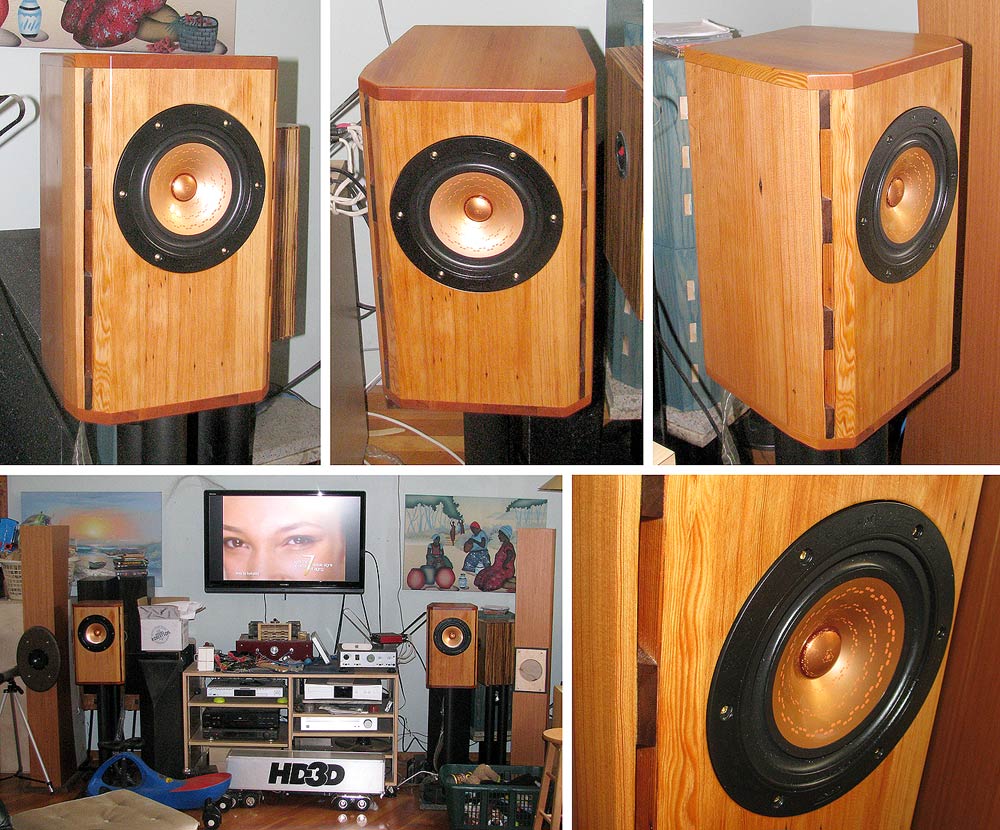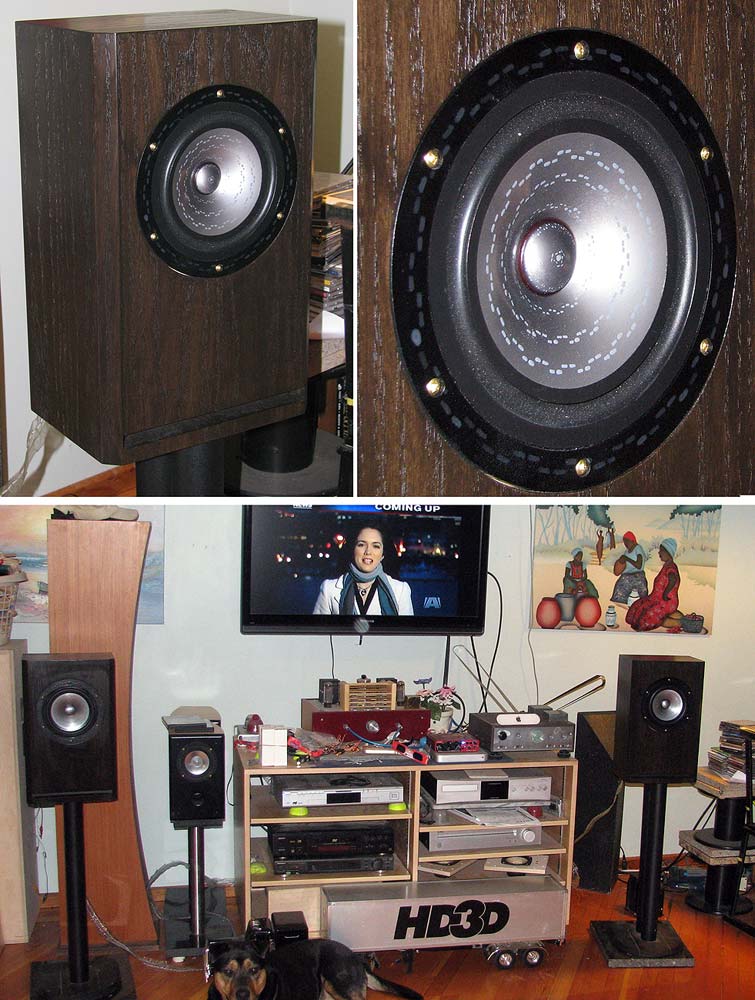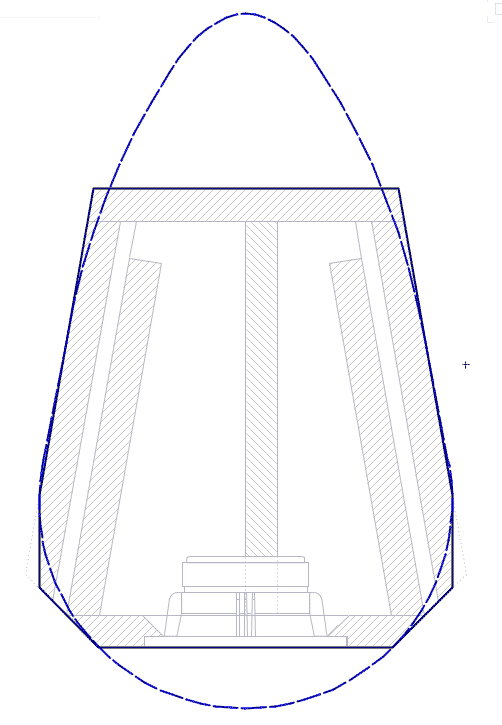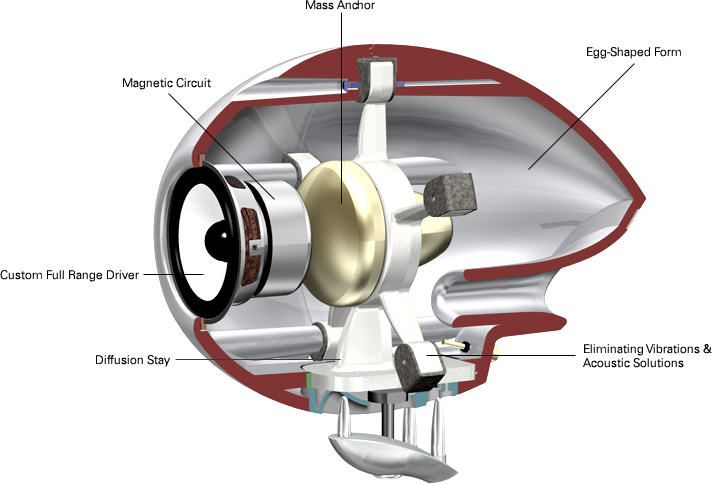This often repeated idea that there is a very strong narrow band first mode internal resonance due to "internal dimension being the same" that gets excited by a single speaker mounted on the side of spherical enclosure isn't actually backed up by any measurements. If you look at the first mode shape for a spherical enclosure, it isn't really efficiently excited from one side of the sphere. I stated that very carefully. If an omni directional source is placed at the center of a spherical enclosure the distance to the sphere from the source is the same in all directions and the first mode is excited. IF drivers were equally spaced all around the sphere, a pulsing sphere, then the first mode would be excited. With a single driver mounted on the side of the sphere you can trace the rays from the driver into the enclosure and you see that the path and reflected sound off the walls do not simply bounce off one wall and then return to the driver with an equal path length. This configuration with one driver does not excite the first mode. It instead excites a range of frequencies low to high in a way that may be worse as you will not be able to avoid playing the speaker in that range and you can't effectively damp that whole range of frequencies, low to high, with stuffing. The same applies to a cube shape enclosure. A very strong coupling to the first mode of an enclosure can be achieved by mounting a driver on a flat surface with a half sphere shell as the enclosure behind the driver. Now the path from the driver to a wall is equal in all directions, save for the dimensions of the cone. Nearly the same can be achieved with a driver with a half cube enclosure. I was intentionally looking to build such a design and was disappointed when I measured a driver centered on the side of a cube as the measured modes did not all line up. When I built the half cube and made measurements I got the very strong first mode at the relatively high frequency that I was hoping for. The over looked advantage of this configuration is that for a given box volume the first mode will be at the highest possible frequency when a half sphere enclosure is used. If you make this volume small enough, the frequency of that first mode is above the operating frequency of the driver. Damping materials are more effective on higher frequencies than low. So it is possible to build a speaker with no acoustic resonances in the pass band with this geometry. A single notch filter in the crossover can also be used to further suppress the driver from exciting this single mode in the crossover transition region. So as I see it a very good design would have a driver with a small half sphere rear enclosure mounted on a much larger spherical baffle. I see no reason to limit the design by coupling the enclosure shape to the baffle shape. I hope that makes sense.The issue is that the internal dimension is the same, which gives a very strong internal resonance. No reference required, that is just geometry.
On the ouside a sphere is very good as long as the driver mounting leaves no discontinuities.
As to the teardrop shape i would reference the work done by B&W and Eclipse.
dave
Last edited:
I have done simialr. A Classic Golden Ratio box vrs the same but in the trapezoidal miniOnken that. in the horizontal plane emulated a teardrop, the trapezoid has an audiably lower diffraction signature.

This shows the shape better:


and this gives a better idea of the shape:

The 2 Alpair 12eN boxes were the actual boxes tested.
And while looking for the above picture i found a better Fujisu TEN insides:

dave

This shows the shape better:

and this gives a better idea of the shape:

The 2 Alpair 12eN boxes were the actual boxes tested.
And while looking for the above picture i found a better Fujisu TEN insides:

dave
I would also be interested in an A-B-C test with a sphere, teardrop and the stock rectangular box the drivers were originally sold in. Guess I have some more fiberglass to lay up and Frank has more whoop tests to do.
After seeing what everyone else has made, I would also agree that the front of my tweeter sphere is too flat. It deviates from a perfect sphere in exactly the wrong way. My bad. Thanks for pointing that out. I expect to make quite a few shapes before settling on something close to optimal. We don't have a hundred thousand pounds to research it like those beautiful teardrop speakers, but these are the sort of things that experts on the forum can help with a lot!
I can see in both teardrop examples, getting the tweeter closer to the midrange cone was more important than maintaining a symmetrical interior shape. In both cases, the tweeter housing intrudes into the interior shape. Is there some sort of tradeoff between having the sound seem to come from one source vs having the sources farther apart and the interior of the cabinet symmetrical? Why not move the tweeter until its rim is touching the rim of the midrange? Do those two drivers need to be separated from each other or should they be brought as close together as physically possible?
The B&W speakers seem to have a rod running down the length of the teardrop on the inside and the Chinese ones have that chrome bullet shape in the center. Does anyone know the purpose of those structures? Would those speakers sound worse if the interior structures were not there?
Thanks again for all the useful suggestions. If a speaker enclosure can be made in any shape at all, what would the ideal shape be? I am intrigued by this mystery shape and want to try to make it with molded fiberglass.
After seeing what everyone else has made, I would also agree that the front of my tweeter sphere is too flat. It deviates from a perfect sphere in exactly the wrong way. My bad. Thanks for pointing that out. I expect to make quite a few shapes before settling on something close to optimal. We don't have a hundred thousand pounds to research it like those beautiful teardrop speakers, but these are the sort of things that experts on the forum can help with a lot!
I can see in both teardrop examples, getting the tweeter closer to the midrange cone was more important than maintaining a symmetrical interior shape. In both cases, the tweeter housing intrudes into the interior shape. Is there some sort of tradeoff between having the sound seem to come from one source vs having the sources farther apart and the interior of the cabinet symmetrical? Why not move the tweeter until its rim is touching the rim of the midrange? Do those two drivers need to be separated from each other or should they be brought as close together as physically possible?
The B&W speakers seem to have a rod running down the length of the teardrop on the inside and the Chinese ones have that chrome bullet shape in the center. Does anyone know the purpose of those structures? Would those speakers sound worse if the interior structures were not there?
Thanks again for all the useful suggestions. If a speaker enclosure can be made in any shape at all, what would the ideal shape be? I am intrigued by this mystery shape and want to try to make it with molded fiberglass.
Last edited by a moderator:
getting the tweeter closer to the midrange cone was more important than maintaining a symmetrical interior shape
In an ideal world the centre-to-centre distance is less than a quarter-wavelength at the XO frequency. In practise this is VERY difficualt so as close as possible is called for.
dave
This helps visualise reflections in a sphere, well it helped me anyway
https://demonstrations.wolfram.com/ReflectionInACircle/
Brian
https://demonstrations.wolfram.com/ReflectionInACircle/
Brian
Hmm, T/S theory peters out at the driver's upper mass corner (Fhm = 2*Fs/Qts'), so it can get up into the mids with even low Fs drivers if a low Qts' and a Vas not optimized for a small box and/or XO'd below this BW.You are correct. I was referring only to low frequency parameters, or just woofer design. T/S parameters are not invoked in design of mid and HF sections of a speaker.
...So as I see it a very good design would have a driver with a small half sphere rear enclosure mounted on a much larger spherical baffle. I see no reason to limit the design by coupling the enclosure shape to the baffle shape. I hope that makes sense.
Let me get this... you have the driver mounted to a semi spherical baffle. The rear of the driver is coupled to a small semi spherical enclosure that has a first mode resonance above the passband of the driver.
So the point of the baffle is to couple the driver to the room... with no baffle step frequencies of any kind. That is interesting. Heck, why not take the baffle design and do whatever to the rear cavity? Particularly for tweeters?
For woofers, you could use a cylindrical rear enclosure with a port at the rear.
Actually, this might be an awesome design with a coaxial driver. The back of the tweeter would be mounted to its little semi spherical cavity while the woofer would see a long "pipe" and would never really see the tweeter at its rear...
I don't know that you would need those complex "egg shaped" enclosures, particularly if the tweeter was in its own world.
Last edited:
I just found this:
"It has been shown by Olson et. al. that the optimum enclosure for a loudspeaker driver is a sphere - that is to say that there is no 'baffle' as such, but that the driver is installed in a spherical enclosure. ..."
https://sound-au.com/bafflestep.htm
"It has been shown by Olson et. al. that the optimum enclosure for a loudspeaker driver is a sphere - that is to say that there is no 'baffle' as such, but that the driver is installed in a spherical enclosure. ..."
https://sound-au.com/bafflestep.htm
To be considered if one wants the lateral radiation to go away with minimal reflection."It has been shown by Olson et. al. that the optimum enclosure for a loudspeaker driver is a sphere - that is to say that there is no 'baffle' as such, but that the driver is installed in a spherical enclosure. ..."
This isn't the only consideration, as this also continually widens the directivity. The other side of the coin is that you need to engage that radiation if you want to maintain directivity.
The better shape is probably the teardrop. But the teardrop has a defitive advantage when deployed into a room, it looks better, more expensive and for a given internal volume is less imposing and more accomodating, physically and visually. They look "cooler" and more high tech. So, regardless if the improvement that the physical shape provides, there is a "wow" factor tha translates into an increased sticker price. And that is good for BW.
Has anyone used concrete for making curved speaker designs? Concrete seems ideal for DIY. Mold any shape easily, cheap, available and non-resonant. Sand molding with a template:
Concrete is definitely an interesting possibility. Cheap, dense, probably makes a great speaker enclosure. After spending like two months learning to make fiberglass ball molds, I watch this video and have to say WOW! That sure went fast. If I was making a set of speakers for myself, I would definitely give concrete a go. I think our speakers will need to be female-rated. That is to say, the female can not come home, find the speakers in her living room and force the male to remove them. Whatever the physics of the sphere vs teardrop argument may be, the teardrop will present a smaller "frontal area" to her room, and represents a possibly more aesthetic shape. This increases the probability of acceptance by the female. As long as the sound of the teardrop vs sphere is the same, I think the teardrop wins the female acceptance test. I also think either shape can be molded and polished to a perfect high gloss finish that is living room rated of it is covered with gelcoat on the outside. I love concrete, especially the way that guy forms it so quickly. Maybe if there were seashells and beach sand glued all over the outside of it? Does anyone know how to make concrete look like something that goes in a living room? Maybe the concrete speakers can go outdoors?
The B&W speakers seem to have a rod running down the length of the teardrop on the inside and the Chinese ones have that chrome bullet shape in the center. Does anyone know the purpose of those structures? Would those speakers sound worse if the interior structures were not there?
In the case pf the B&W the rod is at tension and is what holds the driver in place. In the Eclipse the bit you refer to is part of the “suspension” system. In these the driver is connected to the stand and the enclosure floats around it.
dave
...So as I see it a very good design would have a driver with a small half sphere rear enclosure mounted on a much larger spherical baffle. I see no reason to limit the design by coupling the enclosure shape to the baffle shape.
One of our members (Scandinavian IIRC) that has done just this.
dave
I just found this:
"It has been shown by Olson et. al. that the optimum enclosure for a loudspeaker driver is a sphere...
He is talking about the outside not the outside. There is diffraction from LF to HF. At LF the shape of FR at the transition from 2∏ to 4∏ steriradians is largely determined by the shape of the enclosure.
Here is the meat of Olson’s worl that Rod used to write that piece.

His research was extended by B&W to get the teardrop.
dave
Lots of examples of concreate enclosures. An easy one is a concrete block with baffle & back over the holes.
dave
dave
Did B&W ever write about this?extended by B&W to get the teardrop.
According to the work of LeCleach it could be surmised that following a continually diffracting waveform tends to warrant a continually reducing radius. The sphere at least not increasing.
- Home
- Loudspeakers
- Multi-Way
- How to build a spherical speaker?